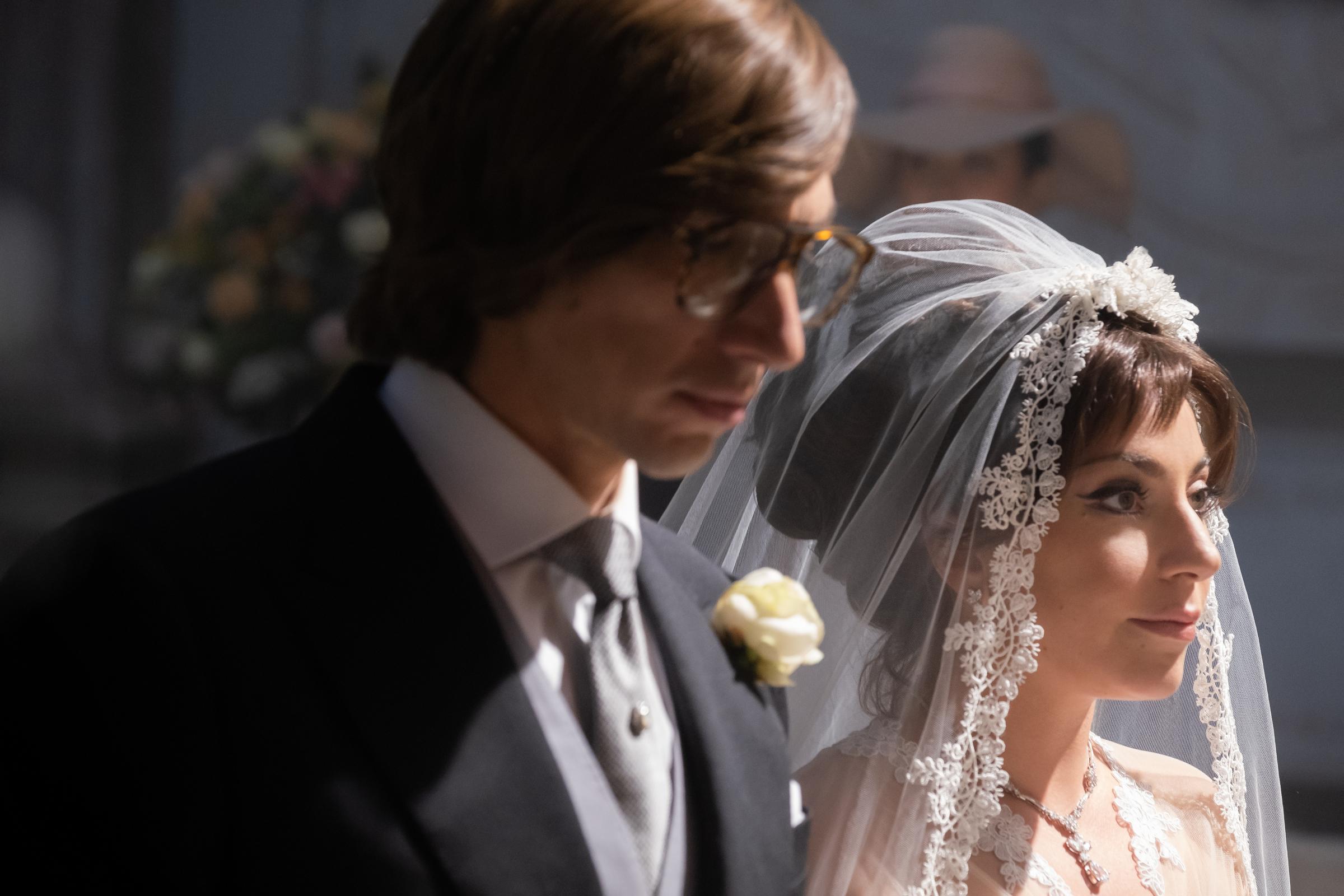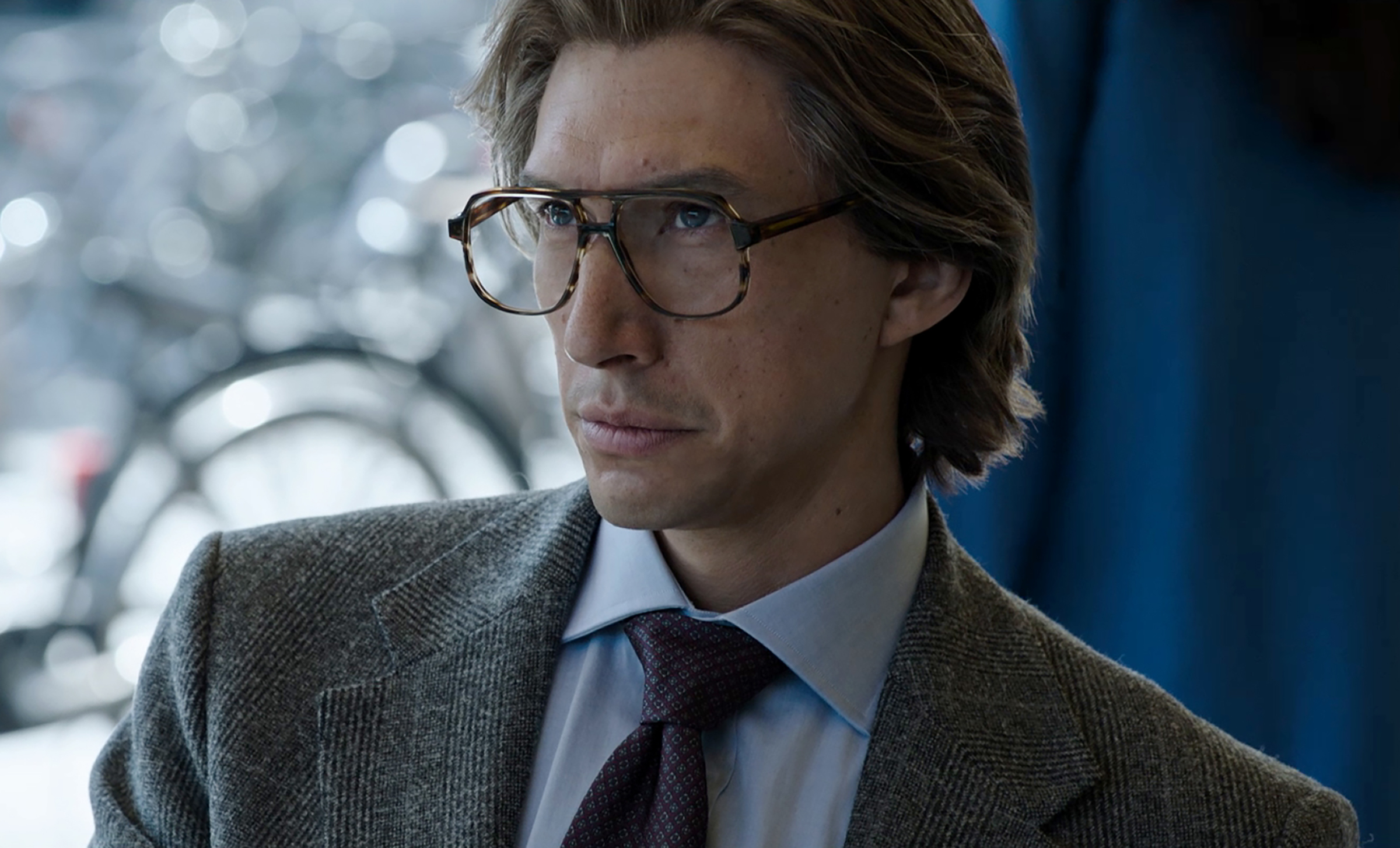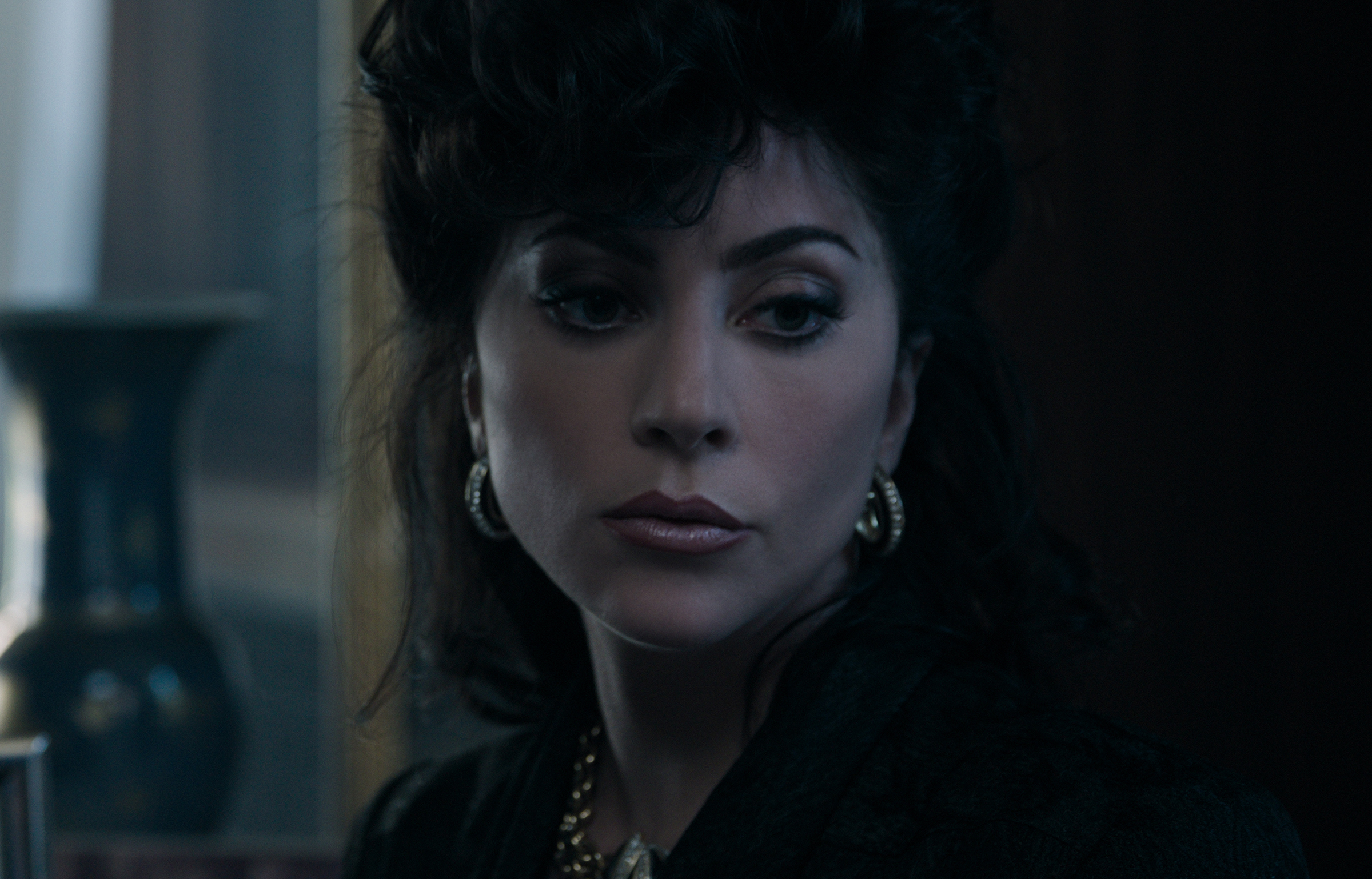The explosive family drama at the center of Ridley Scott’s House of Gucci is so over-the-top that it’s reasonable to assume the film is the result of a very active imagination. In the film, out Nov. 24, the marriage of Patrizia Reggiani (Lady Gaga) and Maurizio Gucci (Adam Driver) implodes as the family business, the House of Gucci, begins to crumble under the pressure of in-fighting and cultural shifts, culminating in the shocking murder of Maurizio.
But in the case of House of Gucci, the truth is truly stranger than fiction. The film was adapted from journalist Sara Gay Forden’s 2001 nonfiction book of the same name, which chronicled the sensational real-life story of the fabulously wealthy Gucci family’s rise and fall as one of fashion’s most prominent dynasties. The tale, which includes Succession-esque rivalries between family members, multiple lawsuits, tax evasion, incarceration and, of course, murder, provided ample creative fodder for Scott and screenwriters Roberto Bentivegna and Becky Johnston.
While the story is based on real people and events, a few elements were changed for the film—intentional choices on the part of Bentivegna, who drew inspiration for the screenplay from flashy films like Sunset Boulevard, Scarface and The Godfather.
“I always wanted with this to feel like the audience was watching a movie,” he tells TIME. “I didn’t want it to feel like it was in any way a near realistic or sort of kitchen sink drama, I really wanted to feel heightened, and really bold and operatic.”
To do this, Bentivegna supplemented his use of Forden’s text with Italian articles from the time about the Gucci family’s public dramas, which he said took on a “tabloid sensationalism” especially surrounding Maurizio’s murder, which was later revealed to be a crime of passion, organized by Patrizia herself.
The element of sensationalism isn’t lost on Forden, who began writing about the Gucci family’s drama as the chief business correspondent for WWD, later drawing on her years of reporting to write her book.
“If I had made the story up like a novel, nobody would have believed it,” she tells TIME. “But it was all true. It’s a timeless story. There are lessons in it, like blood should be thicker than water. And unfortunately, in this case, it wasn’t.”
Here’s what to know about the true story behind House of Gucci.

What to know about the Gucci family
The Gucci fashion house began as a luxury luggage brand founded in 1921 by Guccio Gucci. Guccio was inspired to create his business after a stint working as a bellhop at The Savoy Hotel in London and a gig working for an upscale train travel company. Guccio opened his first shop in Florence in 1921, offering fine leather luggage and accessories, as well as leather goods for horsemen. Guccio’s small shop soon blossomed into a booming family business with many shops in different cities and countries, especially after four of his sons (Vasco, Aldo, Rodolfo and Ugo, who was Guccio’s adopted stepson from his wife’s previous relationship) began working with him. Following Guccio’s death in 1953, shares of the business were left to his three biological sons, Vasco, Rodolfo and Aldo. Looming sibling rivalries between the brothers turned into full-on feuds that continued into the next generation, which helped lead to the downfall of the Gucci family in the fashion industry.
Conflict came to a head after Rodolfo Gucci died in 1983, leaving his son Maurizio a majority stake in the company, which was floundering under the leadership of Aldo. Maurizio, who felt Aldo’s approach of championing the mass production of Gucci products cheapened Gucci’s identity as a luxury brand, spent the majority of the 1980s trying to push him out of the business through legal battles and take over the company. The familial strife during this time was ugly and in the public eye: Aldo served a year in prison for tax evasion and Maurizio fled to Switzerland after being accused of forging his father’s signature to avoid paying inheritance taxes (while he was originally found guilty, he was later acquitted). By 1989, Maurizio had succeeded in taking control of the company and was strongly determined to revamp its image. However, by 1993, Maurizio’s excessive spending and the company’s outstanding debts forced him to sell his 50% percent stake to the business’ investors, ending the Gucci family’s ownership and control of the brand.
Forden says that while the end of the Gucci family dynasty in fashion may be one of the more dramatic incidents in the industry’s history, it was part of a larger trend for Italian fashion during the time, which also affected family companies like Prada, Versace and Armani, which were struggling with transitioning their respective small family boutique businesses into internationally recognized mega brands.
“Gucci tells the story of many family companies that were struggling to kind of get to the next level and wrestling with these questions of succession,” she says. “Obviously, they were challenges in the transformation to the next level and Gucci exemplified that in the most extreme and dramatic way. But I was really touched and compelled by Maurizio Gucci himself, who was on this mission to relaunch his family company to restore it to the top tier of the luxury market.”
Forden also noted that while Maurizio was unable to retain control or ownership of Gucci, he foretold the future of many of these fashion brands, becoming the first to bring in a financial shareholder in order to elevate the brand to the next level.

What to know about Patrizia Reggiani
While Patrizia Reggiani was not born a Gucci, her name looms large in the history of the family. Born Patrizia Martinelli, the future “Lady Gucci” as she would be dubbed during her heyday, grew up poor and not knowing her biological father. When she was 12, her mother married Ferdinando Reggiani, a wealthy entrepreneur, who adopted Patrizia as his own. When she came of age, Patrizia was a socialite in Milan, but despite her stepfather’s wealth, she was not necessarily part of Milan’s high society. According to Forden, Patrizia’s mother was hopeful that her daughter could gain the family entry into these social circles.
Patrizia found an opportunity to join the elite circles of Milan after she met Maurizio at a party in 1970, where he was allegedly impressed with her resemblance to Elizabeth Taylor.
“I met Maurizio at a party and he fell madly in love with me,” Reggiani told The Guardian in a 2016 interview. “I was exciting and different.”

What to know about Patrizia and Maurizio’s marriage and divorce
Maurizio and Patrizia got married in 1972, after two years of courtship, but the union caused a rift in the family. Maurizio’s father, Rodolfo, did not approve of Reggiani’s social background and believed she was a social climber and opted not to attend the couple’s wedding. Rodolfo later reconciled with both his son and daughter-in-law after the birth of their first daughter, Alessandra, in 1976 (the couple had a second daughter, Allegra, in 1981) and even gifted them a luxury penthouse in New York City’s Olympic Tower, where they lived while Maurizio worked for the family business with Aldo.
During the early years of their marriage, Maurizio and Patrizia were active in the New York social scene, often socializing with the likes of Jackie Kennedy Onassis and known for their ostentatious, extravagant lifestyle—the pair were notorious for being chauffeured around Manhattan in a car with a personalized vanity plate with their amalgamated couple’s name, “Mauizia,” and had a yacht and vacation homes Saint Moritz, Acapulco and Connecticut.
Patrizia had an outsize influence on Maurizio in all things, including his dealings with Gucci. According to Bentivegna, Maurizio may have craved Patrizia’s guidance because he grew up as an only child whose mother died when he was very young; by all accounts, Patrizia was well aware that Maurizio’s personality was more timid than hers.
“[Patrizia] famously said that he was like a chair that takes the shape of whoever sits on it,” he says. “So, she as an incredibly sharp and cynical manipulator knew that she had putty in her hands, and she could really mold and play with, but I think it came out of a place of love.”
The couple’s marital problems began in 1983, after Maurizio received a majority stake in the company following the death of his father and attempted to take over the company by launching a legal war to oust his uncles. In an interview with The Guardian, Patrizia claimed that during this time, “Maurizio got crazy. Until then I was his chief adviser about all Gucci matters. But he wanted to be the best, and he stopped listening to me.”
Amid the strife with the family business, Maurizio suddenly severed his relationship with Patrizia. In 1985, after the family had relocated to Milan, Maurizio went on a business trip to Florence, then sent a friend to tell Patrizia that he would not be returning and that their marriage was over. Maurizio began living with Paola Franchi, a childhood friend, in 1991, inciting Patrizia’s jealousy. In 1994, the couple officially divorced, with Patrizia receiving a €2.5 million divorce settlement and a yearly alimony payment of €650,000, which she memorably compared to “a mere bowl of lentils.” Though she lost her legal right to use the surname Gucci in the divorce, Patrizia continued to do so anyway; in an interview with La Republica, she glibly noted: “I still feel like a Gucci—in fact, the most Gucci of them all.”

What actually happened to Maurizio Gucci?
On the morning of March 27, 1995, Maurizio was shot multiple times outside of his office in Milan. He died on the steps of the building in the arms of Giuseppe Onorato, the doorman and only witness to the shooting, who himself was shot. Patrizia was not arrested until 1997, two years after his murder, after police detectives received an anonymous tip. It was later discovered that on the day of Maurizio’s murder, Patrizia wrote one word in her diary, “paradeisos,” Greek for paradise.

What happened at Patrizia’s trial and sentencing?
Patrizia’s trial was a flashy and highly publicized affair, thanks to the Gucci family’s high profile in Italy. She was dubbed the “Black Widow,” a moniker that held more weight once her trial was underway. During the trial, where Patrizia vehemently claimed that she was innocent, the prosecution played tapes of menacing and threatening voicemails that Patrizia had sent Maurizio and Paola, while the defense contended that Patrizia was mentally unstable because of a 1992 operation to remove a brain tumor, which they alleged altered her personality. However, three of the people involved in the scheme (Pina Auriemma, Patrizia’s friend and personal astrologer; Orazio Cicala, the getaway driver; and Ivano Savioni, the man who hired the hitman and driver) confessed to not only their involvement in the murder, but Patrizia’s role in organizing it. Both Patrizia and the hitman who shot Maurizio, Benedetto Ceraulo, denied their charges.
In November 1998, Patrizia was convicted of premeditated murder and sentenced to 29 years in prison, although she only ended up serving 18. Patrizia could have had a shorter tenure in Milan’s San Vittore prison, where she notably was allowed to have a pet ferret, and was eligible for parole in 2011, but she refused, opting to stay in jail, as opposed to joining a work-release program.
“I’ve never worked in my life,” she was reported stating in court. “I won’t start now.”
Patrizia was released in 2016 for good behavior and now works as a consultant for a jewelry company in Milan, where she has been spotted shopping with a parrot on her shoulder. She has since acknowledged her role in the murder of Maurizio, telling an Italian reality TV show when queried why she didn’t shoot her ex-husband herself: “My eyesight is not so good. I didn’t want to miss.”
As for Patrizia’s thoughts on the big screen adaptation of her life, she’s miffed that she was not consulted by Lady Gaga for the film.
“I am rather annoyed at the fact that Lady Gaga is playing me in the new Ridley Scott film without having had the consideration and sensibility to come and meet me,” she told ANSA, an Italian wire service. However, Bentivegna is not convinced that Patrizia isn’t somewhat impressed that the film was made.
“I think Patrizia is going to love the movie and I think she’s thrilled that it’s being made,” he says. “I think she’s incredibly flattered that Lady Gaga is playing her, because she is, to put it mildly, self-absorbed.”
What the Gucci family has to say about House of Gucci film adaptation
Following the release of the film, the family of Aldo Gucci released a statement in ANSA, slamming the movie for showing “one narrative that is far from accurate.” In the statement, the Gucci family called out the film’s production for not consulting them before portraying Aldo and the rest of the family on-screen; they also took issue with the film’s depiction of Patrizia Reggiani as a sort of feminist foil to the male leadership of the company. Variety reported via an anonymous source that despite the severe statement, the Gucci family is not seeking legal action against Scott’s production company or Warner Bros.
Read the full statement, translated from Italian, below.
The Gucci family takes note of the release of the film “House of Gucci” with some bewilderment because, although the work claims to want to tell the “true story” of the family, the fears aroused by the trailers and interviews released so far, are confirmed: the film carries one narrative that is far from accurate.
The production of the film did not bother to consult the heirs before describing Aldo Gucci – president of the company for 30 years – and the members of the Gucci family as thugs, ignorant and insensitive to the world around them, attributing notes to the protagonists, events, tones and attitudes that never belonged to them. This is extremely painful from a human point of view and an insult to the legacy on which the brand is built today.
Even more censurable is the reconstruction that becomes mystifying on the edge of the paradox when it comes to suggesting indulgent tones towards a woman who, definitively convicted of having been the instigator of the murder of Maurizio Gucci, is not painted only in the film, but also in the statements of the cast members, as a victim that was trying to survive in a masculine and macho corporate culture.
This couldn’t be further from the truth. Moreover, in the 70 years of history in which it was a family business, Gucci was an inclusive company. Indeed, precisely in the 1980s – the historical context in which the film is set – women were in different top positions: whether they were members of the family or extraneous to it, they included the president of Gucci America, the Head of Global PR & Communication, and a member of the board of directors of Gucci America.
Gucci is a family that lives honoring the work of its ancestors, whose memory does not deserve to be bothered to stage a film that is not true and that does not do justice to its protagonists.
The members of the Gucci family reserves every right to protect the name, image and the dignity of their loved ones.
More Must-Reads from TIME
- Cybersecurity Experts Are Sounding the Alarm on DOGE
- Meet the 2025 Women of the Year
- The Harsh Truth About Disability Inclusion
- Why Do More Young Adults Have Cancer?
- Colman Domingo Leads With Radical Love
- How to Get Better at Doing Things Alone
- Michelle Zauner Stares Down the Darkness
Write to Cady Lang at cady.lang@timemagazine.com